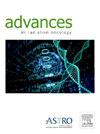Child-Pugh A 与 Child-Pugh B/C 肝硬化患者肝细胞癌立体定向体放射治疗后的疗效比较
IF 2.2
Q3 ONCOLOGY
引用次数: 0
摘要
目的对于肝细胞癌(HCC)患者,立体定向体放射治疗(SBRT)已成为一种局部治疗方法。我们的目的是报告Child-Pugh A(CP A)与Child-Pugh B或C(CP B/C)肝功能异常的HCC患者接受SBRT治疗后的疗效。方法和材料一家医疗机构对80例HCC患者进行了回顾性分析,共有94个肿瘤接受了SBRT治疗。比较了 CP A(51 例)和 CP B/C(29 例)肝功能异常患者的治疗结果。结果平均肿瘤大小为 3.2 厘米。CP A队列中有59个肿瘤,CP B/C队列中有35个肿瘤。CP A队列的中位放射剂量为50 Gy(5次/分),CP B/C队列的中位放射剂量为40 Gy(5次/分)。两组的病理完全反应率相似,CP A 组为 63%,CP B/C 组为 61%。两组的估计 1 年局部控制率相似,CP A 组为 93%,CP B/C 组为 91%(P = 0.59)。CP A 组的 1 年 OS 为 85%,而 CP B/C 组的 1 年 OS 为 61% (P = .19)。结论我们的研究结果表明,SBRT 对 CP A 和 CP B/C 肝功能不全患者是可行且有效的,尽管 CP B/C 组群的放射剂量较低,但其局部控制率和病理完全反应率相似。在 CP B/C 晚期肝硬化患者中,毒性较高,必须与可能的治疗效果进行权衡。有必要进一步研究 SBRT 在晚期肝硬化患者中的最佳作用。本文章由计算机程序翻译,如有差异,请以英文原文为准。
Outcomes After Stereotactic Body Radiation for Hepatocellular Carcinoma in Patients With Child-Pugh A Versus Child-Pugh B/C Cirrhosis
Purpose
For patients with hepatocellular carcinoma (HCC), stereotactic body radiation therapy (SBRT) has emerged as a locoregional treatment. Our purpose was to report outcomes in patients with HCC with Child-Pugh A (CP A) versus Child-Pugh B or C (CP B/C) liver dysfunction treated with SBRT.
Methods and Materials
A retrospective analysis of 80 patients with HCC, with a total of 94 tumors treated with SBRT, was conducted at a single institution. Outcomes were compared between patients with CP A (n = 51) and CP B/C (n = 29) liver dysfunction. Outcomes of interest included local control, overall survival (OS), and toxicity.
Results
Median tumor size was 3.2 cm. There were 59 tumors included in the CP A cohort and 35 tumors in the CP B/C cohort. Median radiation dose was 50 Gy in 5 fractions for the CP A cohort and 40 Gy in 5 fractions for the CP B/C cohort. The rates of pathologic complete response were similar between the 2 groups at 63% for the CP A group and 61% for the CP B/C group. The estimated 1-year local control rates were similar between the 2 groups at 93% for the CP A group and 91% for the CP B/C group (P = .59). The 1-year OS for the CP A group was 85%, whereas the 1-year OS for the CP B/C group was 61% (P = .19). There was a 5.9% rate of grade 3+ toxicity in the CP A group and a 20.7% rate of grade 3+ toxicity in the CPB/C group.
Conclusions
Our findings suggest that SBRT is feasible and effective in patients with both CP A and CP B/C liver dysfunction with similar rates of local control and pathologic complete response despite lower radiation doses in the CP B/C cohort. In patients with more advanced CP B/C cirrhosis, toxicities were higher and must be weighed against possible treatment benefits. Further studies characterizing the optimal role of SBRT in patients with advanced cirrhosis are warranted.
求助全文
通过发布文献求助,成功后即可免费获取论文全文。
去求助
来源期刊

Advances in Radiation Oncology
Medicine-Radiology, Nuclear Medicine and Imaging
CiteScore
4.60
自引率
4.30%
发文量
208
审稿时长
98 days
期刊介绍:
The purpose of Advances is to provide information for clinicians who use radiation therapy by publishing: Clinical trial reports and reanalyses. Basic science original reports. Manuscripts examining health services research, comparative and cost effectiveness research, and systematic reviews. Case reports documenting unusual problems and solutions. High quality multi and single institutional series, as well as other novel retrospective hypothesis generating series. Timely critical reviews on important topics in radiation oncology, such as side effects. Articles reporting the natural history of disease and patterns of failure, particularly as they relate to treatment volume delineation. Articles on safety and quality in radiation therapy. Essays on clinical experience. Articles on practice transformation in radiation oncology, in particular: Aspects of health policy that may impact the future practice of radiation oncology. How information technology, such as data analytics and systems innovations, will change radiation oncology practice. Articles on imaging as they relate to radiation therapy treatment.
 求助内容:
求助内容: 应助结果提醒方式:
应助结果提醒方式:


